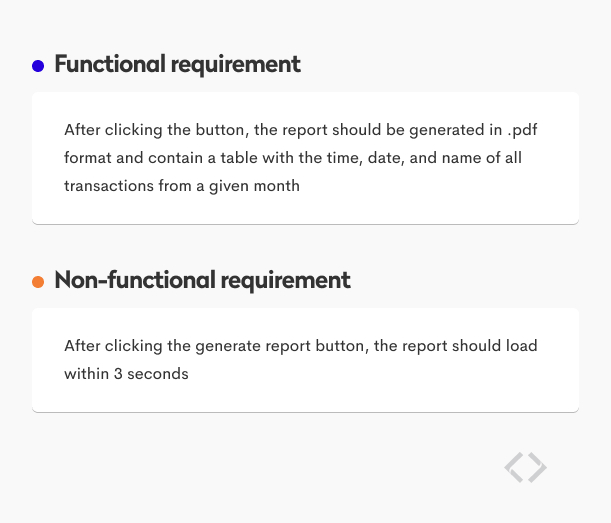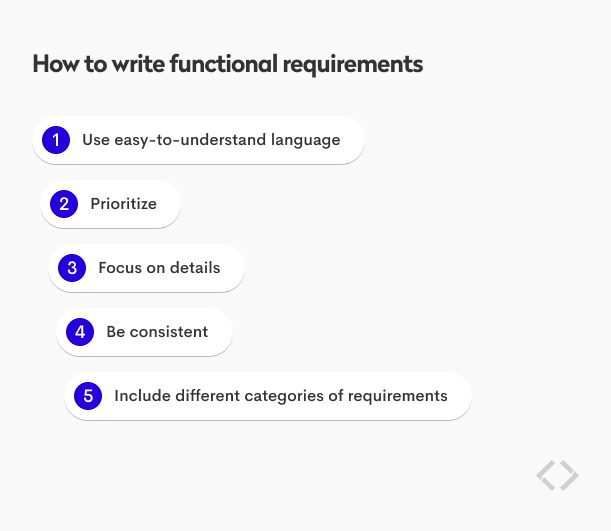Functional Requirements in Software Engineering: Top Tips for Writing a Clear Document
Creating an IT system that satisfies all of its users’ needs means meeting a range of functional app requirements. If these requirements are ignored or poorly defined, projects can take longer than planned.
Collecting requirements is essential for the success of any project, as it helps the development team to define the project scope and understand the customer’s needs. The process is important since poorly formulated requirements can cause delays and increase the project budget by 60%.
Table of Contents
Functional requirements definition
Functional app requirements describe the behavior of the system under certain conditions and define the product’s features and functions. These requirements range from technical details to data processing and authentication – anything that reflects the intended behavior of the IT system.
How do functional requirements differ from non-functional requirements? In short, functional requirements in software engineering describe what an application must do, i.e., they refer to specific functionalities. Non-functional requirements refer to the conditions in which the application operates. Note that each functional requirement typically has a set of related non-functional requirements. Have a look at this example:
What supports the creation of functional requirements?
1.User story
User stories are the best way to describe functionalities that should be implemented in an IT product. This allows you to present features and properties of the system from the user’s perspective, so you can show how the user uses the application. To write a user story that reflects user needs, it’s good to use the following template: “As a [user], I want [what?] so that [reason/value].”
An example of a user story based on this template is the following description: As an administrator, I want to be able to generate reports to know how many users visit my website.
You can add details to a story, usually by choosing one of two approaches:
- dividing the user story into several shorter stories, or
- adding so-called conditions of satisfaction, which are acceptance criteria – rules describing the conditions that must be met to achieve the intended goal.
2. Acceptance criteria
Acceptance criteria are the specific conditions and requirements that indicate that a user story is complete. They help determine whether a given functionality is met.
Acceptance criteria should only describe a product’s minimum level of functionality and features – in other words, only those elements must be developed. Below you’ll find an example of the acceptance criteria for the above user story.
- The reports should be generated by the administrator.
- The report should be generated in .xcs format.
- The report should consist of the user ID, date, name of the visited page, and the time spent on the page.
- Reports should be generated for the previous month.
- Reports should be generated after clicking the button.
3. Event storming workshops
To create functional requirements more easily, start with a general app functionality description and then focus on the details. This approach to creating specifications, combined with event storming workshops organized by the software house, will help you understand the scope of the product and its functionality.
Event storming workshops are especially useful when the project specification is incomplete or lacks specific usage scenarios, defined problems, or business logic.
How to write functional requirements
When writing functional requirements, follow good practices to improve the application development process. There is no single roadmap for this, but the following rules will work for every project.
- Write succinctly — use plain and easy-to-understand language to avoid misinterpretation and misunderstanding.
- Prioritize — functional requirements have different weightings, so each must relate to a specific business goal or user requirement.
- Focus on the details — try not to combine multiple requirements. The more precise and detailed the requirements, the easier it is to manage them.
- Be consistent — make sure that no requirements are contradictory.
- Include different categories of requirements — e.g., business, administrative, user requirements, or system requirements.
- Create functionalities that are easy to test and verify — after ending the project, it will help you determine whether the requirements have been met.
The most common mistakes in requirements specifications
It’s essential to write technical specifications that contain functional and non-functional requirements, but it’s also necessary to properly formulate the given requirements. Below is a list of the most common mistakes people make when creating a list of functional requirements.
- Missing acceptance criteria
- Confusing, hard-to-understand language
- Creating a user story without sticking to the scheme, which makes it difficult to understand necessary requirements
- Inaccurate representation of user’s needs, based on requirements of the main user, without consideration of others
- A failure to describe specific modules, an inaccurate app description, or a lack of important information necessary to accurately define requirements
- Writing in general terms that lack essential details
- Inappropriate prioritization and problems with determining what’s more important
When writing functional requirements, it’s important to use simple language, without technical jargon, to avoid misunderstandings. Each requirement should relate to one goal and be testable.
Functional requirements — summary
Writing functional app requirements using words everyone knows will save time and eliminate the need to organize many meetings. The less time you spend on meetings, the more time you spend working on the project. A decent specification also helps you identify errors early and correct them, saving time and resources.
Ensuring that requirements are clearly and precisely documented – in a way that leaves no room for misunderstanding – can help you avoid project delays and extra costs.






